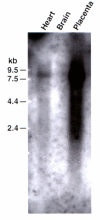The cloning, genomic organization and tissue expression profile of the human DLG5 gene
- PMID: 11876824
- PMCID: PMC77411
- DOI: 10.1186/1471-2164-3-6
The cloning, genomic organization and tissue expression profile of the human DLG5 gene
Erratum in
-
The cloning, genomic organization and tissue expression profile of the human DLG5 gene: Correction.BMC Genomics. 2002 Jun 11;3:14. doi: 10.1186/1471-2164-3-14. Epub 2002 Jun 11. BMC Genomics. 2002. PMID: 12060488 Free PMC article. No abstract available.
Abstract
Background: Familial atrial fibrillation, an autosomal dominant disease, was previously mapped to chromosome 10q22. One of the genes mapped to the 10q22 region is DLG5, a member of the MAGUKs (Membrane Associated Gyanylate Kinase) family which mediates intracellular signaling. Only a partial cDNA was available for DLG5. To exclude potential disease inducing mutations, it was necessary to obtain a complete cDNA and genomic sequence of the gene.
Methods: The Northern Blot analysis performed using 3' UTR of this gene indicated the transcript size to be about 7.2 KB. Using race technique and library screening the entire cDNA was cloned. This gene was evaluated by sequencing the coding region and splice functions in normal and affected family members with familial atrial fibrillation. Furthermore, haploid cell lines from affected patients were generated and analyzed for deletions that may have been missed by PCR.
Results: We identified two distinct alternately spliced transcripts of this gene. The genomic sequence of the DLG5 gene spanned 79 KB with 32 exons and was shown to have ubiquitous human tissue expression including placenta, heart, skeletal muscle, liver and pancreas.
Conclusions: The entire cDNA of DLG5 was identified, sequenced and its genomic organization determined.
Figures


Similar articles
-
cDNA cloning and gene structure of a novel water channel expressed exclusively in human kidney: evidence for a gene cluster of aquaporins at chromosome locus 12q13.Genomics. 1996 Aug 1;35(3):543-50. doi: 10.1006/geno.1996.0396. Genomics. 1996. PMID: 8812490
-
[Analysis, identification and correction of some errors of model refseqs appeared in NCBI Human Gene Database by in silico cloning and experimental verification of novel human genes].Yi Chuan Xue Bao. 2004 May;31(5):431-43. Yi Chuan Xue Bao. 2004. PMID: 15478601 Chinese.
-
Cloning and genomic organization of beclin 1, a candidate tumor suppressor gene on chromosome 17q21.Genomics. 1999 Jul 1;59(1):59-65. doi: 10.1006/geno.1999.5851. Genomics. 1999. PMID: 10395800
-
[cDNA cloning, subcellular localization and tissue expression of a new human Krüppel-like transcription factor: human basic Krüppel-like factor (hBKLF)].Yi Chuan Xue Bao. 2003 Jan;30(1):1-9. Yi Chuan Xue Bao. 2003. PMID: 12812068 Chinese.
-
A double-edged sword: DLG5 in diseases.Biomed Pharmacother. 2023 Jun;162:114611. doi: 10.1016/j.biopha.2023.114611. Epub 2023 Mar 29. Biomed Pharmacother. 2023. PMID: 37001186 Review.
Cited by
-
The Crohn's disease susceptibility gene DLG5 as a member of the CARD interaction network.J Mol Med (Berl). 2008 Apr;86(4):423-32. doi: 10.1007/s00109-008-0307-5. Epub 2008 Mar 12. J Mol Med (Berl). 2008. PMID: 18335190
-
Meta-analysis of associations between DLG5 R30Q and P1371Q polymorphisms and susceptibility to inflammatory bowel disease.Sci Rep. 2016 Sep 16;6:33550. doi: 10.1038/srep33550. Sci Rep. 2016. PMID: 27633114 Free PMC article.
-
Loss of Dlg5 expression promotes the migration and invasion of prostate cancer cells via Girdin phosphorylation.Oncogene. 2015 Feb 26;34(9):1141-9. doi: 10.1038/onc.2014.31. Epub 2014 Mar 24. Oncogene. 2015. PMID: 24662825
-
DLG5 variants do not influence susceptibility to inflammatory bowel disease in the Scottish population.Gut. 2005 Oct;54(10):1416-20. doi: 10.1136/gut.2005.066621. Epub 2005 Apr 20. Gut. 2005. PMID: 15843420 Free PMC article.
-
Molecular genetic analysis of six Dutch families with atrial fibrillation.Neth Heart J. 2005 Aug;13(7-8):269-273. Neth Heart J. 2005. PMID: 25696507 Free PMC article.
References
-
- Marfatia SM, Morais Cabral JH, Lin L, Hough C, Bryant PJ, Stolz L, et al. Modular organization of the PDZ domains in the human discs-large protein suggests a mechanism for coupling PDZ domain-binding proteins to ATP and the membrane cytoskeleton. J Cell Biol. 1996;135:753–766. doi: 10.1083/jcb.135.3.753. - DOI - PMC - PubMed
-
- Thomas U, Phannavong B, Muller B, Garner CC, Gundelfinger ED. Functional expression of rat synapse-associated proteins SAP97 and SAP102 in Drosophila dlg-1 mutants: effects on tumor suppression and synaptic bouton structure. Mech Dev. 1997;62:161–174. doi: 10.1016/S0925-4773(97)00658-8. - DOI - PubMed
Grants and funding
LinkOut - more resources
Full Text Sources
Molecular Biology Databases

